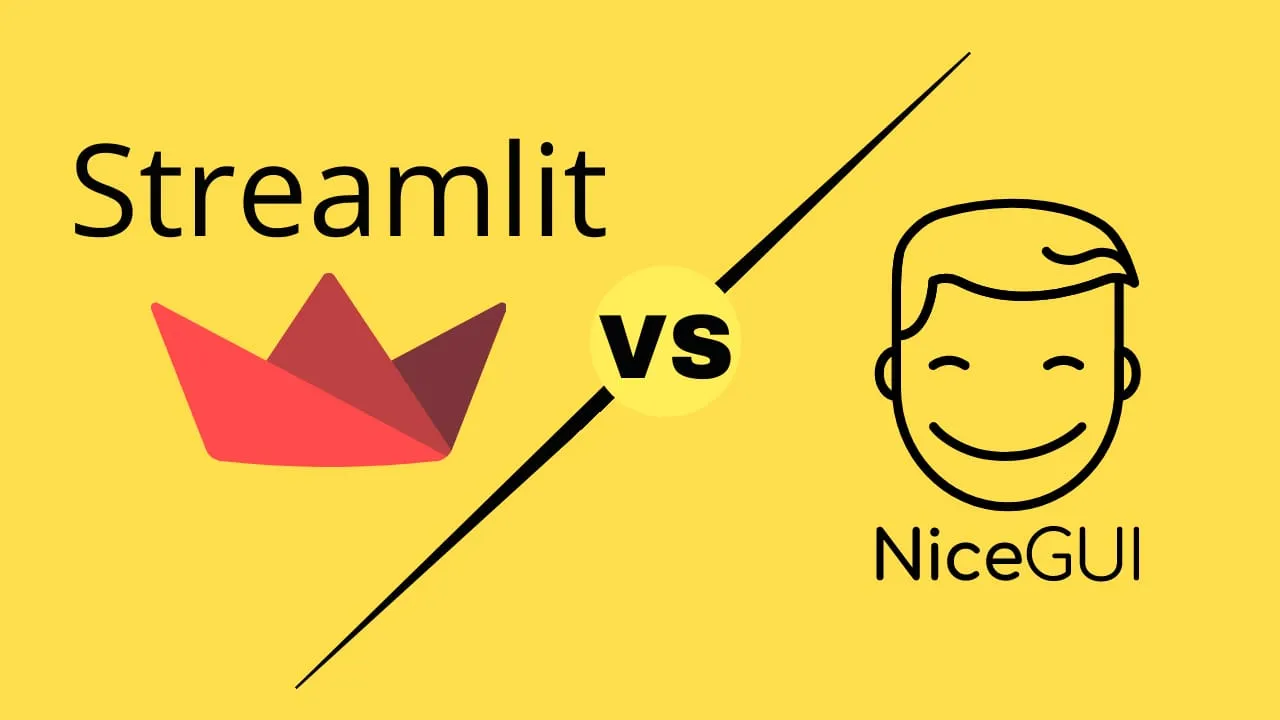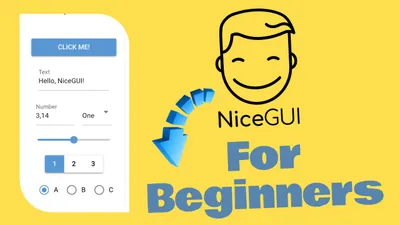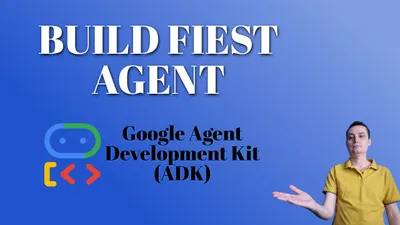Streamlit vs. NiceGUI: Choose the Best Python Web Framework
Streamlit and Taipy are two popular tools for creating web apps from Python scripts. But which one is better for your data projects?

Table of Contents
Python is a popular programming language for data science, machine learning, web development, and more. However, Web applications with Python can be challenging, especially for beginners. Fortunately, there are some frameworks that make it easier to build interactive and beautiful WEB applications with Python. Two of them are Streamlit and NiceGUI.
Streamlit is an open-source framework that lets you create web apps for data exploration, visualization, and machine learning with minimal code. You can write your app logic in Python and Streamlit will automatically generate a web interface for it. You can also use widgets, charts, maps, tables, and other components to enhance your app. For deploying Streamlit on your VPS you can check: Deploy Streamlit on a VPS and Proxy to Cloudflare Tunnel
NiceGUI is a newer framework that aims to provide a simple and elegant way to create GUIs with Python. It uses Vue, Quasar, and Tailwind for its frontend, which allows you to create web-based GUIs with HTML, CSS, and JavaScript. You can check NiceGUI for Beginners to find out more.
In case you are interested in checking the best Python web frameworks see: Best Python Web Frameworks.
10 Differences Between Streamlit and NiceGUI
- Streamlit: Prioritizes rapid development and simplified coding for data-focused web apps.
- NiceGUI: Excels in desktop-like experiences, granular control, and flexibility.
Streamlit and NiceGUI, while both serving the purpose of creating GUIs in Python, have distinct differences that set them apart:
-
Underlying Technologies: Streamlit is built specifically for data science applications, while NiceGUI is designed with a focus on web-based user interfaces and runs on top of FastAPI
-
Ease of Use: Both frameworks are user-friendly, but Streamlit is particularly noted for its simplicity in deploying projects without requiring knowledge of HTML, CSS, or JavaScript
-
Customization: NiceGUI offers advanced customization through its extensibility and allows developers to dive into HTML, CSS, and JavaScript if needed
-
Community and Support: Streamlit has a larger community and more resources available, such as forums and challenges like the #30DaysOfStreamlit
-
Deployment: Streamlit apps can be deployed on Streamlit Cloud with certain limitations, such as a 1GB resource limit and apps going to sleep if not visited
-
Backend Capabilities: NiceGUI is built on FastAPI, which provides additional backend functionalities like authentication and routing
-
Frontend Technologies: NiceGUI uses Vue, Quasar, and Tailwind for its frontend, which are abstracted away from the user, allowing them to focus on Python code
-
License: Streamlit is released under the Apache License 2.0, while NiceGUI is under the MIT License
-
Learning Resources: Streamlit provides a variety of learning resources, including a blog and a gallery of apps for inspiration
-
Primary Use Case: Streamlit is often the go-to for machine learning and data science projects, whereas NiceGUI is more versatile for different types of web-based interfaces
Which One is Better for Building Interactive GUIs, Streamlit or NiceGUI?
The “better” framework depends entirely on the level of interactivity and complexity your GUI requires. Here’s a breakdown:
-
Streamlit: Streamlit is excellent for creating interactive dashboards, visualizations, and web apps where the user’s actions primarily change the displayed data or trigger pre-defined computations. Its widgets and layout functionality support various use cases.
-
NiceGUI: NiceGUI shines when building GUIs mimicking desktop applications. It enables fine-grained control over event handling, intricate interactions between components, and real-time responsiveness. This makes it suitable for applications demanding a high degree of user control.
Factors to Consider:
-
Responsiveness: If your GUI needs immediate feedback to user actions without full page reloads, NiceGUI may be more suitable.
-
Layout: For complex layouts with dynamic resizing and unconventional widget arrangements, NiceGUI provides greater flexibility.
-
Custom Interactions: Need custom behaviors beyond standard widgets? NiceGUI allows deeper interactions.
Which One is More Beginner-Friendly, Streamlit or NiceGUI
Streamlit has a reputation for being exceptionally beginner-friendly. Here’s why:
-
Minimal Coding: Streamlit’s declarative style lets you create web apps with a few lines of Python code. You don’t need HTML or JavaScript knowledge.
-
Intuitive Layout: The linear, top-down logic makes understanding the flow of Streamlit apps a breeze.
-
Rapid Prototyping: Streamlit’s dynamic updates let you see the impact of your code changes almost instantly, speeding up experimentation.
NiceGUI, while approachable, does demand a slightly stronger foundation in traditional GUI principles:
-
Event-Driven Model: You’ll need to understand how events (like button clicks) trigger updates in the GUI.
-
UI Definition: Building a NiceGUI layout involves more explicit programming structures for arranging elements.
Streamlit Code Example:
import streamlit as st
st.title('My First Streamlit App')
number = st.slider('Select a number', 0, 100)
st.write('You selected:', number)NiceGUI Code Example:
import nicegui as ui
ui.label('My First NiceGUI App')
number = ui.slider(0, 100)
ui.label('You selected: {}'.format(number.value))
ui.run()In Summary, Streamlit boasts a gentler learning curve for those new to GUI development. However, NiceGUI is still readily accessible, especially if you have some basic Python experience.
What Are The Advantages of Using Nicegui Over Streamlit
The advantages of using NiceGUI over Streamlit are numerous, catering to a wide range of development needs and preferences. Here’s a detailed look at these advantages:
-
Browser as the Frontend: NiceGUI allows any browser to serve as the frontend for Python code, making it highly versatile for various projects, including dashboards, robotics, IoT solutions, smart home automation, and machine learning applications.
-
Unified Codebase: With NiceGUI, developers can stay within the Python ecosystem for both frontend and backend development, simplifying the development process by keeping all code in one place. This contrasts with other frameworks that may require splitting frontend and backend technologies.
-
Gentle Learning Curve: NiceGUI is designed to be accessible to developers of all skill levels, offering a gentle learning curve while still providing the option for advanced customizations. This makes it an attractive option for those new to web development or those who prefer to focus on Python coding without delving into HTML, CSS, or JavaScript.
-
Backend Capabilities: Running on top of FastAPI, NiceGUI enables the addition of authentication, routing, OpenAPI specs, and other backend functionalities to projects. This backend-first philosophy ensures that web development details are handled efficiently, allowing developers to concentrate on writing Python code.
-
Advanced Customization: Despite its simplicity, NiceGUI offers advanced customization options through its extensibility. Developers have the option to go all the way down to HTML, CSS, and JavaScript if needed, providing flexibility for more complex projects.
-
Integration with Modern Web Technologies: The frontend of NiceGUI is implemented using Vue, Quasar, and Tailwind. However, familiarity with these technologies is not required to create beautiful user interfaces, as NiceGUI abstracts these details away from the developer.
-
Lightweight and Docker Support: NiceGUI is more lightweight than Streamlit and is available both as a PyPI package and in Docker. This flexibility in deployment options can be particularly beneficial for projects with specific infrastructure requirements.
-
Automatic Refresh: One of the standout features of NiceGUI is its ability to automatically refresh the browser upon code modifications. This eliminates the need for manual reloads or reruns, streamlining the development process and enhancing productivity.
-
Standard and High-Level GUI Components: NiceGUI provides a wide range of standard GUI components like labels, icons, checkboxes, switches, and more. It also offers powerful high-level components for creating 3D landscapes, drawing graphs and charts, and receiving inputs from simulated joysticks, among others.
-
Ease of Use with Standard Python Constructs: NiceGUI encourages the use of standard Python constructs such as callbacks and if-statements, making it easy for developers to get started and build interactive applications without needing to learn new paradigms.
In summary, NiceGUI offers a comprehensive and accessible framework for building web-based user interfaces directly from Python code. Its focus on simplicity, user-friendliness, and the ability to handle both frontend and backend development within the Python ecosystem makes it a compelling choice for a wide range of projects.
Advantages of Using Streamlit Over NiceGUI
Streamlit offers several advantages over NiceGUI, particularly for developers working on data science and machine learning projects. Here are some of the key benefits:
-
Simplicity and Rapid Development: Streamlit is designed with simplicity in mind, enabling developers to quickly turn data scripts into shareable web apps. It’s structured to facilitate rapid development without the need for extensive knowledge of frontend technologies.
-
Data-Centric Widgets: Streamlit provides a limited but powerful set of widgets that are specifically tailored for data analysis, such as sliders, which can be very useful for creating interactive data visualizations.
-
Community and Resources: Streamlit has a growing community and a wealth of resources available for developers. This includes forums, discussions, and a variety of learning materials that can help new users get started and experienced users to solve complex problems.
-
Fully Open Source: Streamlit is fully open source, which means that all of its features are available to the community without restrictions. This can be particularly appealing for developers who prefer to work with open-source tools.
-
Integration with Python Plotting Libraries: Streamlit integrates well with Python plotting libraries such as Bokeh or Altair, making it a strong choice for developers who are already familiar with these tools and want to create rich, interactive data visualizations.
-
Persistent Webpage Content: Unlike NiceGUI, which restores the page contents to their initial state after a disconnection, Streamlit maintains the state of the webpage content, which can be crucial for user experience, especially when dealing with dynamic content.
-
Ease of Use Without Jupyter: Streamlit does not require the use of Jupyter Notebooks, which can be a plus for developers looking for a more flexible and standalone solution for data dashboarding.
-
Instant Visual Feedback: Streamlit’s model for designing the UI provides instant visual feedback, which can be a significant advantage when creating interfaces that need to be intuitive and user-friendly.
-
Integrated Communication Across Network Boundaries: Streamsync, a framework related to Streamlit, highlights the seamless integration of communications across network boundaries, which can simplify the development process by making API calls and response parsing invisible to the developer.
-
Focus on Data Dashboarding: Streamlit is specifically built as a data dashboarding solution, making it a more mature option for developers whose primary goal is to develop interactive dashboards for non-technical users.
In conclusion, Streamlit’s focus on data science, ease of use, and strong community support make it an attractive option for developers looking to create interactive web applications backed by Python code, especially when data visualization and analysis are at the core of the project.
Conclusion
Choosing the right framework hinges on your specific project needs:
-
Streamlit excels in rapid prototyping, dashboards, and data-driven apps where ease of development and streamlined data presentation are vital.
-
NiceGUI triumphs when customization, desktop-like interactivity, and precise control over user interactions are primary requirements.
There’s no single “best” framework—they both offer compelling advantages depending on your use case.
Related Posts

NiceGUI For Beginners: Build An UI to Python App in 5 Minutes
Master NiceGUI quickly! Learn to add a user interface to your Python app in just 5 minutes with our beginner-friendly guide.

Getting Started with uv: Setting Up Your Python Project in 2025
See how you can get started with uv, a next-generation Python package and project manager written in Rust by the Astral team.

How to Build Your First Agent with Google Agent Development Kit (ADK)
Learn how you can start building your first agent with Google Agent Development Kit (ADK) and add memory and tool use to browse the web.